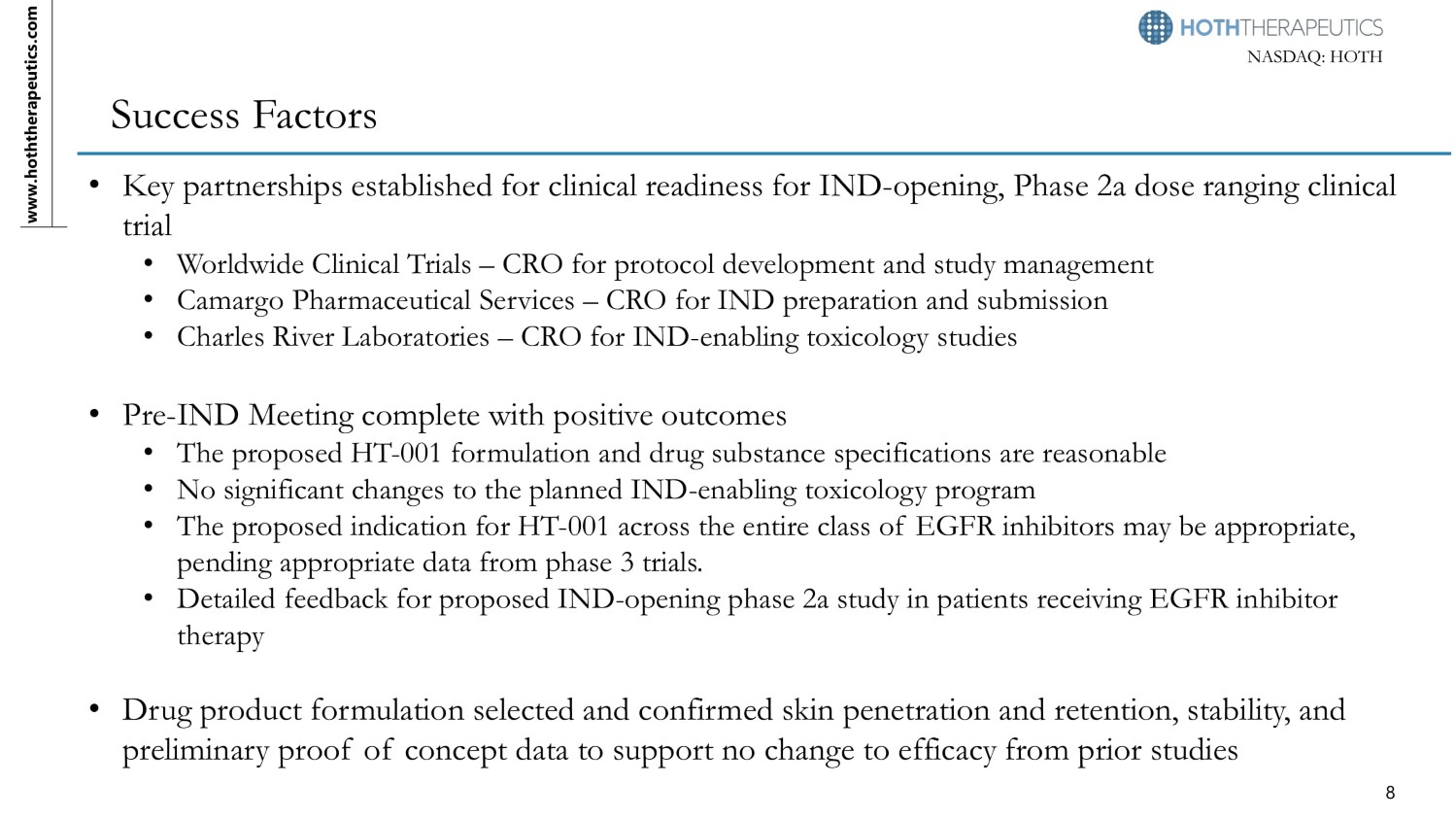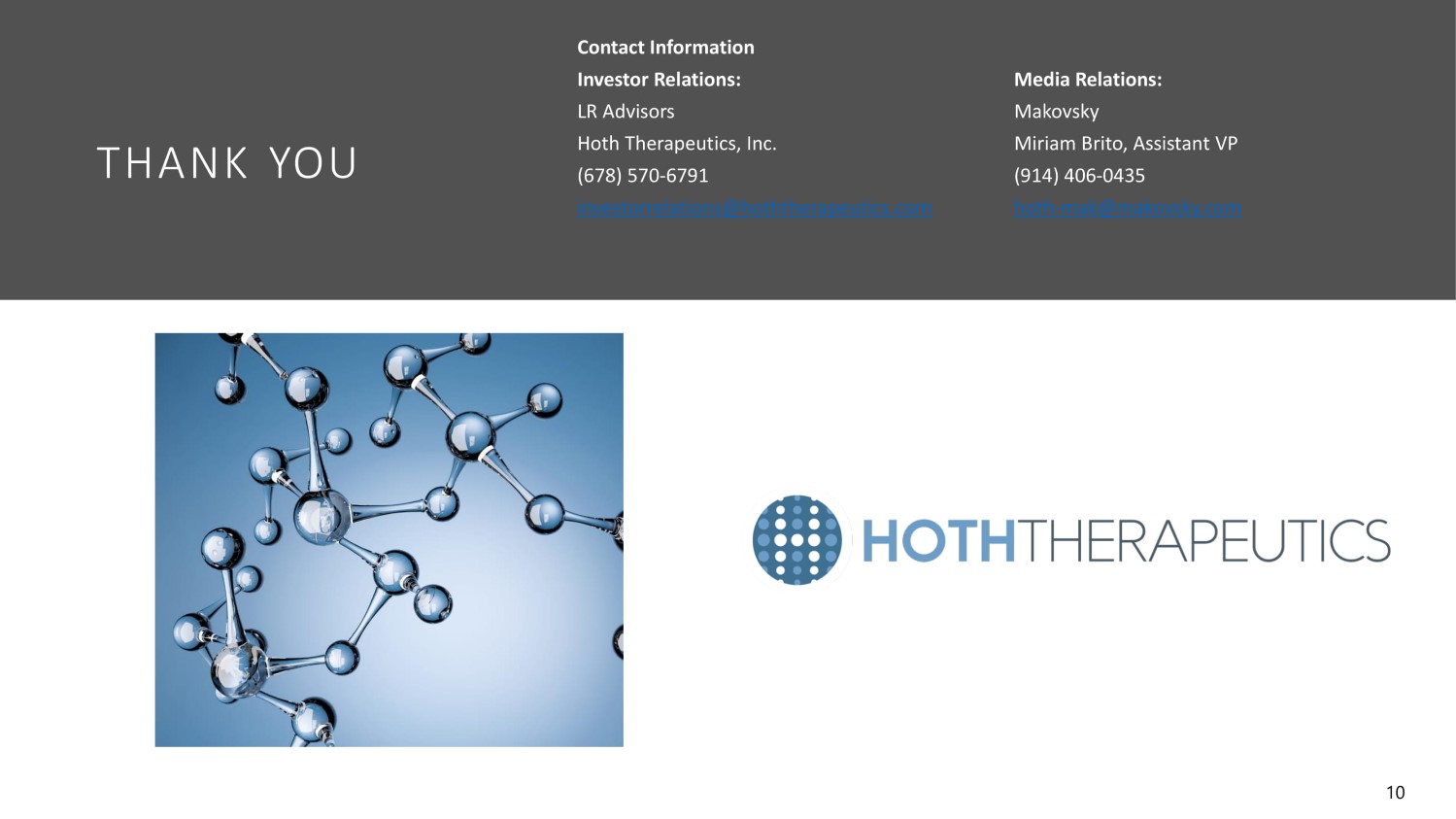Attached files
| file | filename |
|---|---|
| EX-99.1 - PRESENTATION MATERIALS - HT-KIT - Hoth Therapeutics, Inc. | ea141512ex99-1_hoththerap.htm |
| 8-K - CURRENT REPORT - Hoth Therapeutics, Inc. | ea141512-8k_hoththerapeutics.htm |
Exhibit 99.2

m o c . s c NASDAQ: HOTH i t u e ap r e h t h t o h www. 1 Introduction to HT - 001 Topical Gel

www.hoththerapeutics.com N A S D A Q: HOTH 2 Safe Harbor Sta t ement This presentation contains "forward - looking statements" within the meaning of the “safe - harbor” provisions of the Private Securities Litigation Reform Act of 1995 . These statements are identified by the use of words “could,” “believe,” “anticipate,” “intend,” “estimate,” “expect,” “may,” “continue,” “predict,” “potential” and similar expressions that are intended to identify forward - looking statements . Such statements involve known and unknown risks, uncertainties and other factors that could cause the actual results of Hoth Therapeutics, Inc . (“Hoth” or the “Company”) to differ materially from the results expressed or implied by such statements . These forward - looking statements are made on the basis of the current beliefs, expectations and assumptions of management, are not guarantees of performance and are subject to significant risks and uncertainty . These forward - looking statements should, therefore, be considered in light of various important factors, including those set forth in Hoth’s reports that it files from time to time with the Securities and Exchange Commission (the “Commission”) and which you should review, including those statements under “Item 1 A – Risk Factors” in Hoth’s Annual Report on Form 10 - K, as amended by its Quarterly Reports on Form 10 - Q and other reports that Hoth files with the Commission . Important factors that could cause actual results to differ materially from those described in forward - looking statements contained in this presentation include, but are not limited to : the adverse impact on economies around the world of the current COVID - 10 pandemic ; changes to our anticipated sources of revenues ; competitive conditions ; difficulties in obtaining regulatory approvals for the Company’s product candidates ; changes in economic and political conditions ; the success of our research and development initiates ; and other factors . These forward - looking statements should not be relied upon as predictions of future events and Hoth cannot assure you that the events or circumstances discussed or reflected in these statements will be achieved or will occur . If such forward - looking statements prove to be inaccurate, the inaccuracy may be material . You should not regard these statements as representation or warranty by Hoth or any other person that we will achieve our objectives and plans in any specified timeframe, or at all . You are cautioned not to place undue reliance on these forward - looking statements, which speak only as of the date of this presentation . The Company disclaims any obligations to publicly update or release any revisions to the forward - looking information contained in this presentation, whether as a result of new information, future events or otherwise, after the date of this presentation or to reflect the occurrence of unanticipated events, except as required by law .

www.hoththerapeutics.com N A S D A Q: HOTH Introduction to HT - 001 Topical Gel • Novel Primary Indication • Treatment of mild to moderate cutaneous toxicities (skin, scalp, nails) associated with EGFR inhibitor cancer therapy • No other drugs approved for this indication • Qualifies as a “serious condition” to pursue FDA expedited programs (Fast Track, Breakthrough Designation, Priority Review) • 505(b)(2) Regulatory Pathway • Hoth has exclusive license from George Washington University for worldwide territory 3

www.hoththerapeutics.com N A S D A Q: HOTH Background: Cutaneous Toxicities Associated with EGFR Inhibitor Therapy • Currently 11 EGFR inhibitor drugs are approved by FDA for the treatment of a variety of cancer types, including breast cancer, non - small cell lung cancer (NSCLC), pancreatic cancer, colorectal cancer, squamous - cell carcinoma of the head and neck, and medullary thyroid cancer • Cutaneous toxicities are the most common side effect of EGFR inhibitor therapy • Most frequently occurring disorders include 1,2 : • papulopustular (acneiform) rash (45 to 100%) • dry and itchy skin (12 to 16%) • microbial infections (38 to 70%) • nail changes (12% – 16%) • xerosis (7% – 35%) • pruritus (10% – 16%) • alopecia (5% – 6%) • EGFR therapy dose modification (10 - 50% reduction) has been reported to occur in up to 60% of cases and discontinuation of EGFR therapy in 32% of cases 3 4

www.hoththerapeutics.com 5 N A S D A Q: HOTH Background: HT - 001 Mechanism of Action • EGFR signaling is critical to maintain skin homeostasis; inhibition results in high influx of inflammatory cells and production of proinflammatory cytokines in the skin • HT - 001 is anticipated to inhibit recruitment and activation of immune cells, reducing inflammation H T - 001 Figure adapted from Lichtenger 2013, et al

www.hoththerapeutics.com Erlotinib - Induced Dermatological Effects in Rats are Rescued by Concurrent Treatment with HT - 001 • Oral administration of 5.85 mg/kg/day erlotinib, with or without 1.15 mg/kg/day HT - 001 for 12 weeks • In comparison to erlotinib - only treatment, concomitant treatment with HT - 001 showed: • Resolution of erlotinib - induced dermatitis and hair loss • Significant reduction in substance P • Significant reduction in neutrophil activity • Restoration of cardiac dysfunction 6 N A S D A Q: HOTH HT - 001 Significantly Reduces EGFR Inhibitor - Induced Cutaneous Toxicity Co n t r ol Erlotinib Erlotinib + HT - 001

www.hoththerapeutics.com 7 N A S D A Q: HOTH HT - 001 505(b)(2) Development Pathway Current estimated dates; pending FDA meetings for phase 2b/phase 3 clinical studies NDA Submission Pre - IND Meeting Final Formulation Selection 2021 Clinical Readiness: Toxicology studies GMP Drug Manufacture Protocol Development Site Selection and Activation IND Submission Phase 2a Clinical Study (US only) 2022 EOP2 FDA Meeting 2023 2024 Phase 2b Clinical Study (TBD) 2025 Phase 3 Clinical Study(s) (TBD) Chronic Toxicology Studies R egistra t ion Batches Type C FDA Meeting In - P r oce s s 2026 2027 Pre - NDA Meeting

www.hoththerapeutics.com N A S D A Q: HOTH Success Factors • Key partnerships established for clinical readiness for IND - opening, Phase 2a dose ranging clinical trial • Worldwide Clinical Trials – CRO for protocol development and study management • Camargo Pharmaceutical Services – CRO for IND preparation and submission • Charles River Laboratories – CRO for IND - enabling toxicology studies • Pre - IND Meeting complete with positive outcomes • The proposed HT - 001 formulation and drug substance specifications are reasonable • No significant changes to the planned IND - enabling toxicology program • The proposed indication for HT - 001 across the entire class of EGFR inhibitors may be appropriate, pending appropriate data from phase 3 trials. • Detailed feedback for proposed IND - opening phase 2a study in patients receiving EGFR inhibitor therapy • Drug product formulation selected and confirmed skin penetration and retention, stability, and preliminary proof of concept data to support no change to efficacy from prior studies 8

www.hoththerapeutics.com N A S D A Q: HOTH R eferences 1. Eilers, R. E., Gandhi, M., Patel, J.D., Mulcahy, M.F., Agulnik, M., Hensing, T., Lacouture, M.E. (2009). Dermatologic Infections in Cancer Patients Treated With Epidermal Growth Factor Receptor Inhibitor Therapy. J Natl Cancer Inst 102, 47 – 53. 2. Lichtenberger, B.M., Gerber, P.A., Holcmann, M., Buhren, B.A., Amberg, N., Smolle, V., Schrumpf, H., Boelke, E., Ansari, P., Mackenzie, C., et al. (2013). Epidermal EGFR Controls Cutaneous Host Defense and Prevents Inflammation. Sci. Transl. Med. 5, 199ra111. 3. Boone, S. L., Rademaker, A., Liu, D., Pfeiffer, C., Mauro, D.J., Lacouture, M.E. (2007). Impact and Management of Skin Toxicity Associated with Anti - Epidermal Growth Factor Receptor Therapy: Survey Results. Oncology 72(3 - 4):152 - 9. 9

m o c . s c NA S D A Q: HOTH i t u e ap r e h t h t o h www. T HAN K Y O U Co n t act I n f orm a tion Investor Relations: LR Advisors Hoth Therapeutics, Inc. (678) 570 - 6791 investorrelations@hoththerapeutics.com Media Relations: Makovsky Miriam Brito, Assistant VP (914) 406 - 0435 hoth - mak@makovsky.com 10
